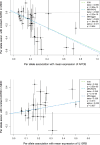This is a preprint.
Proteogenomic signature of risk of Alzheimer's disease and related dementia risk in individuals with a history of major depression disorder
- PMID: 39314945
- PMCID: PMC11419236
- DOI: 10.1101/2024.09.11.24313493
Proteogenomic signature of risk of Alzheimer's disease and related dementia risk in individuals with a history of major depression disorder
Update in
-
Proteogenomic signature of Alzheimer's disease and related dementia risk in individuals with major depressive disorder.Nat Ment Health. 2025 Aug;3(8):879-888. doi: 10.1038/s44220-025-00460-0. Epub 2025 Jul 14. Nat Ment Health. 2025. PMID: 40823340 Free PMC article.
Abstract
The mechanisms linking a history of major depressive disorder (MDD) to an increased risk of Alzheimer's disease and related dementia (ADRD) are not fully understood. Using the UK Biobank available proteomic and genomic data, we evaluated the biological mechanisms linking both conditions. In participants with a history of MDD at baseline (n=3,615), we found that plasma levels of NfL, GFAP, PSG1 were associated with higher risk (HR=1.38; 1.37; 1.34, respectively; all adjusted p-values<0.05), while VGF, GET3, and HPGDS were associated with lower risk of incident ADRD (n=150) (HR=0.73; 0.71; 0.66, respectively; all adjusted p-values<0.05) during a mean follow-up of 13.7 years (SD=2.2). Two-sample Mendelian randomization analysis using cis-pQTLs genetic instruments revealed that a lower protein expression of apolipoprotein E and higher IL-10 receptor subunit B were causally linked to incident ADRD. Finally, we developed a Proteomic Risk Score (PrRSMDD-ADRD), which showed strong discriminative power (C-statistic = 0.84) to identify participants with MDD that developed ADRD upon follow-up. In addition to demonstrating an association between plasma proteins associated with inflammation and future ADRD risk in individuals with MDD, our findings include an element of causality using Mendelian Randomization (MR) and PrRSMDD-ADRD can be useful to identify individuals with the highest risk to develop ADRD in a highly vulnerable population.
Keywords: Alzheimer’s disease; Major depressive disorder; dementia; genomics; inflammation; proteomics.
Conflict of interest statement
Conflict of interest: Dr. Diniz serves as a consultant to Bough Bioscience Inc in an area unrelated to this work. The other authors report no conflict of interest.
Figures




References
-
- Morris G, Puri BK, Walker AJ, Maes M, Carvalho AF, Bortolasci CC et al. Shared pathways for neuroprogression and somatoprogression in neuropsychiatric disorders. Neurosci Biobehav Rev 2019; 107: 862–882. - PubMed
-
- Lynch CJ, Gunning FM, Liston C. Causes and Consequences of Diagnostic Heterogeneity in Depression: Paths to Discovering Novel Biological Depression Subtypes. Biol Psychiatry 2020; 88(1): 83–94. - PubMed
-
- Whiteford HA, Degenhardt L, Rehm J, Baxter AJ, Ferrari AJ, Erskine HE et al. Global burden of disease attributable to mental and substance use disorders: findings from the Global Burden of Disease Study 2010. Lancet 2013; 382(9904): 1575–1586. - PubMed
Publication types
Grants and funding
LinkOut - more resources
Full Text Sources
Miscellaneous
